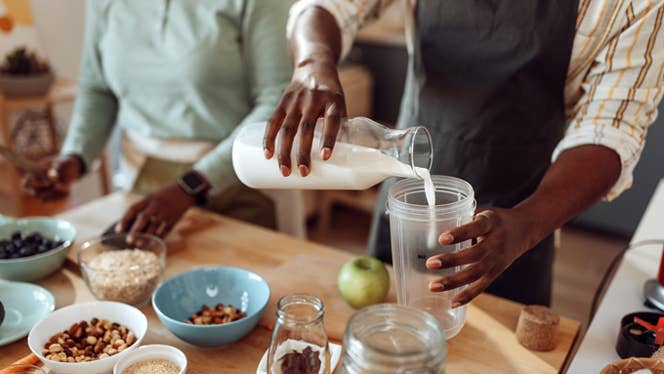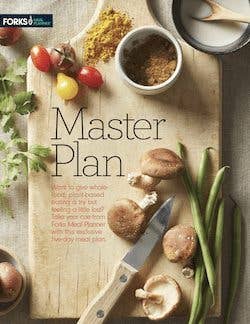
How to Find Healthy Plant-Based Milk, Plus Best Picks for Cooking, Baking
It seems like every time you go to the store, there’s another new type of vegan milk that promises to be richer, frothier, or creamier than any that has come before it. Here’s how to get past the marketing ploys and flashy packaging to find a healthy plant-based milk for your cooking and baking needs.
What Is Vegan Milk (aka Plant Milk)?
All vegan milks (also known as “plant milks” or “plant-based milks”) are essentially made the same way: by blending a grain, legume, or nut with water, then straining out the solids. They’re easy to make at home (see below), but it’s hard to beat the convenience of plant milks from the supermarket. These milks have been pasteurized or ultra-pasteurized just like dairy milk to eliminate any harmful microorganisms and extend their shelf life.
Refrigerated vs. Shelf-Stable Vegan Milk
The main difference between shelf-stable and refrigerated milks (dairy or plant-based) is how they are packaged.
Shelf-stable plant milk is always ultra-pasteurized. It’s heated to an ultra-high temperature (280˚F to 302˚F) for several seconds to effectively sterilize it and kill any harmful microorganisms. After this step, the milk is packed into sterile, aseptic containers that keep the milk fresh and pathogen-free at room temperature for up to eight months. Once opened, shelf-stable plant milk will stay fresh in the fridge for up to 10 days, just like milk purchased from the refrigerator case.
Choosing between refrigerated or shelf-stable plant milk is a matter of personal preference. Many brands use the same formulas for both their refrigerated and shelf-stable products. Some even stock their shelf-stable products in the refrigerated section so that they are more appealing and appear more drinkable.
What to Look for in a Store-Bought Plant Milk
Vegan milks now represent 16% of the milk consumed in the United States. The plant-based milk market is forecast to be a $38 billion global business in 2024, and that number is expected to triple by 2030.
As the vegan milk market continues to grow, there are more tasty options than ever to choose from. There are also more nutritional pitfalls to avoid, as companies try to find formulations that please the palates of an ever-growing number of consumers.
To find the healthiest options, the first thing you should do when shopping for vegan milk is to check the ingredients and look for the following.
Two (or Three) Ingredients
The purest, least-processed plant milks will have just two ingredients: the main component (e.g., soybeans or almonds) and water. Sometimes a little salt is added to enhance flavor.
Minimal Processing
Think pea milk sounds pure and healthy? Think again. The relatively new kid on the plant milk block is made with pea protein, which is extracted from dried yellow peas. Similarly, flax, hemp, and sesame milk are often blended with highly processed ingredients. A good rule of thumb is to avoid plant milks that have the words “extracted” or “protein” on the ingredients label. They indicate a high level of processing to obtain the ingredient.
No Oils, Emulsifiers, or Gums
To increase creaminess and sensory appeal, many plant milk brands use emulsifiers, thickeners, and gums (such as xanthan gum). Some research suggests that, when consumed regularly, these ingredients may disrupt the gut microbiome and increase inflammation. Oil is another common plant-milk additive that whole-food, plant-based eaters will want to steer clear of when shopping.
Zero Added Sugar
Many vegan milks contain refined sugar, but there are also plenty of “unsweetened” varieties available. We recommend opting for these. (You can always add a little sweetener yourself for flavor.)
Allergens?
If you have food sensitivities, check the ingredient list carefully to be sure the beverage you choose is suitable for you. Plant milk blends can contain ingredients not necessarily advertised on the front of the packages.
The 3 Best Plant Milks for Cooking and Baking
While most plant milks are interchangeable in recipes, each yields slightly different results when used in cooking and baking. Here’s a quick rundown of the best options and what each does especially well.
Soy Milk
Great for baking and savory recipes
With its pale color, neutral flavor, and a protein and fat content that is closest to dairy milk, soy milk is one of the best plant milk options for baking. The protein and fat keep baked goods meltingly tender and encourage dark, golden browning. Taste for yourself when you use soy milk to make Vegan Strawberry Cupcakes or a showstopping Polenta Cake with Apples and Cherry Compote. Soy milk’s neutral flavor also makes it a good addition to savory dishes like mashed potatoes, where you’re looking to impart creaminess (but not sweetness) to the final dish.
Nut Milk
Great all-purpose milk
Rich-tasting nut milks’ nutty flavor ranges from subtle (almond and cashew) to bold (hazelnut and walnut). They’re an excellent all-purpose plant milk because they’re great in baked goods, pancakes, and French toast. Their nutty taste can also add a subtle dimension to pasta sauce, such as in our Penne Pesto. And they taste good on morning cereal. The pale color, creamy texture, and hint of flavor make them nut milks best for nice creams, too.
Oat Milk
Great for baking, soups, stews
Of all the plant milks available, oat milk is the highest in natural sugars. Use it to add a little sweetness to naturally sweetened cakes and cookies. Oat milk works especially well in chocolate desserts, because the dark chocolate helps hide oat milk’s slightly beige color. (See our Sweet Potato Chocolate Pudding and Banana and Chocolate Peanut Butter Brownies.) Because it doesn’t curdle when exposed to heat, oat milk makes a wonderful creamy-without-the-cream addition to soups and stews.
How to Make Your Own Vegan Milk
You may be surprised by how easy it is to make plant milk at home. Here are a few resources to get you started.
To learn delicious vegan recipes and master whole-food, plant-based culinary techniques at home, check out Forks Over Knives Online Cooking Courses!

Free Download
Free 5-day meal plan!
Get a taste for healthy, fuss-free meal planning with this free five-day meal plan from Forks Meal Planner!
By providing your email address, you consent to receive newsletter emails from Forks Over Knives. We value your privacy and will keep your email address safe. You may unsubscribe from our emails at any time.

About the Author

About the Author
Mary Margaret Chappell
Join our mailing list
Get free recipes and the latest info on living a happy, healthy plant-based lifestyle.
By providing your email address, you consent to receive newsletter emails from Forks Over Knives. We value your privacy and will keep your email address safe. You may unsubscribe from our emails at any time.